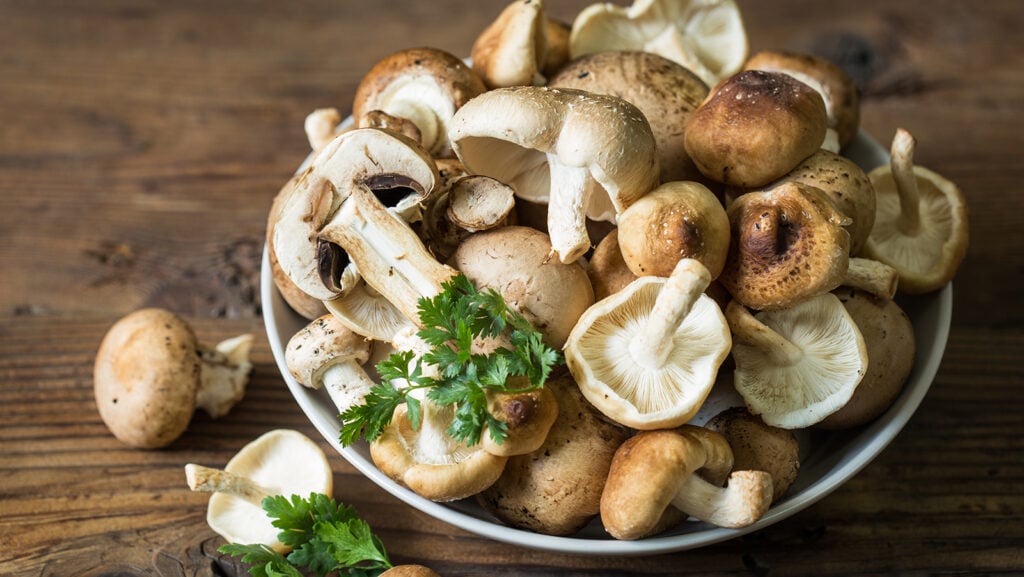Mushrooms come in all shapes and sizes. From the very small chestnut or button to the gigantic portobello often featured in plant-based dishes due to its meaty texture.
Let’s not forget shiitake, oyster, porcini, or chanterelles. They’re also incredibly versatile as an ingredient, featuring in a range of dishes from risottos to quiches to pasta or more simply sauteed with herbs and garlic and served as a side.
But are mushrooms good for you? The short answer is yes, very much so. Mushrooms play a unique role in keeping us healthy: let’s explore this now.
The only plant-based source of vitamin D
Do you know mushrooms, grown under UV light or outdoors, are the only plant-based source of vitamin D?
Very few foods contain vitamin D. And, during the winter months, when there isn’t sufficient UVB radiation to produce it naturally, we run the risk of not having enough.
How does vitamin D support our bodies?
During COVID-19, with increased reporting on how we can support our immune systems, many of us will already be aware of one of its roles.
However, our immune systems are sophisticated and complex involving a network of cells, tissues, and organs that work together to protect against infection and disease. Many different micronutrients play a role. Hence why it’s important to eat a balanced and varied diet to ensure you are consuming a wider range of nutrients.
Vitamin D is also linked to good bone health. This is because it aids the regulation of calcium and phosphorus metabolism and mood.
In a recent study published in Psychological Medicine, vitamin D deficiency and insufficiency were risk factors for the development of new-onset depression in middle-aged adults.
How many mushrooms should I eat to get my vitamin D quota?
Eating a portion or serving of mushrooms (around 80-100g) can provide you with your daily vitamin D requirements e.g. 1 large portobello mushroom, 11-14 button mushrooms, or 4-5 chestnut mushrooms.
Make sure your mushrooms are grown under UV light (rather than in the dark) and check the nutritional content on the package to confirm their vitamin D content. Remember, it’s also advisable during the winter months when there isn’t sufficient UVB light for our bodies to produce it naturally, to supplement with 10mcg.
In fact, during the sunnier months of March-September, you can naturally increase the vitamin D content of your mushrooms by placing them in the light on the windowsill or outdoors for about an hour when the sun is at its highest (ideally between 11 am and 3 pm).
What other nutrients do mushrooms contain?
If this key nutrient wasn’t enough, mushrooms also contain a range of B vitamins including B2, B3 (niacin), and B5. Some mushrooms also contain vitamin B12, which is difficult to consume enough of when eating a meat-free diet. They’re also high in antioxidants such as selenium which is believed to protect cells from damage, reduce chronic disease and inflammation. And, as per all plant-based foods, mushrooms contain fiber which keeps our gut microbiome happy.
Are they good for the environment?
As vegetables go, mushrooms also fair pretty well from a sustainability perspective. In the UK, they’re grown year-round. This means they can be transported by road rather than air, reducing their food miles and carbon footprint.
How to store and clean mushrooms
As with other fresh food, there can be some confusion about how they should be stored to get the best from them.
To keep your mushrooms as fresh as possible, they should be stored in their original packaging. Or, in a paper bag in the fridge. Leave your mushrooms on the windowsill in the sun for an hour before consumption to top up their vitamin D .
How long do mushrooms last in the fridge? If stored correctly (see above), mushrooms should stay fresh for about a week to 10 days.
Instead of washing mushrooms, you should brush them instead or wipe them with a damp paper towel. This will stop them from soaking up water and going soggy.
How do you cook mushrooms?
As mentioned earlier, mushrooms are incredibly versatile. While you can eat them raw, you can also saute them in oil and herbs and served on toast or as a side, added to your favorite pasta dish, or turned into a mighty plant-based burger.
How to sauté mushrooms
A simple dish involving one pan and ready in a few minutes.
Ingredients:
- olive oil
- sliced mushrooms (as many as you need – 80g is a portion)
- 1 clove garlic, finely chopped (add another if making more than 2-3 portions)
- salt & pepper
- optional: fresh herbs, roughly chopped
Method:
Cover the base of a hot frying pan with some oil and allow to heat for a moment over medium heat. Then, throw in the sliced mushrooms and allow to cook for a couple of minutes until just starting to brown. Add in the garlic and cook for a further minute until it all smells deliciously garlicky and the mushrooms are a deep brown color. Take off the heat, season to taste, and stir through any herbs you want to use. Serve straight away.






